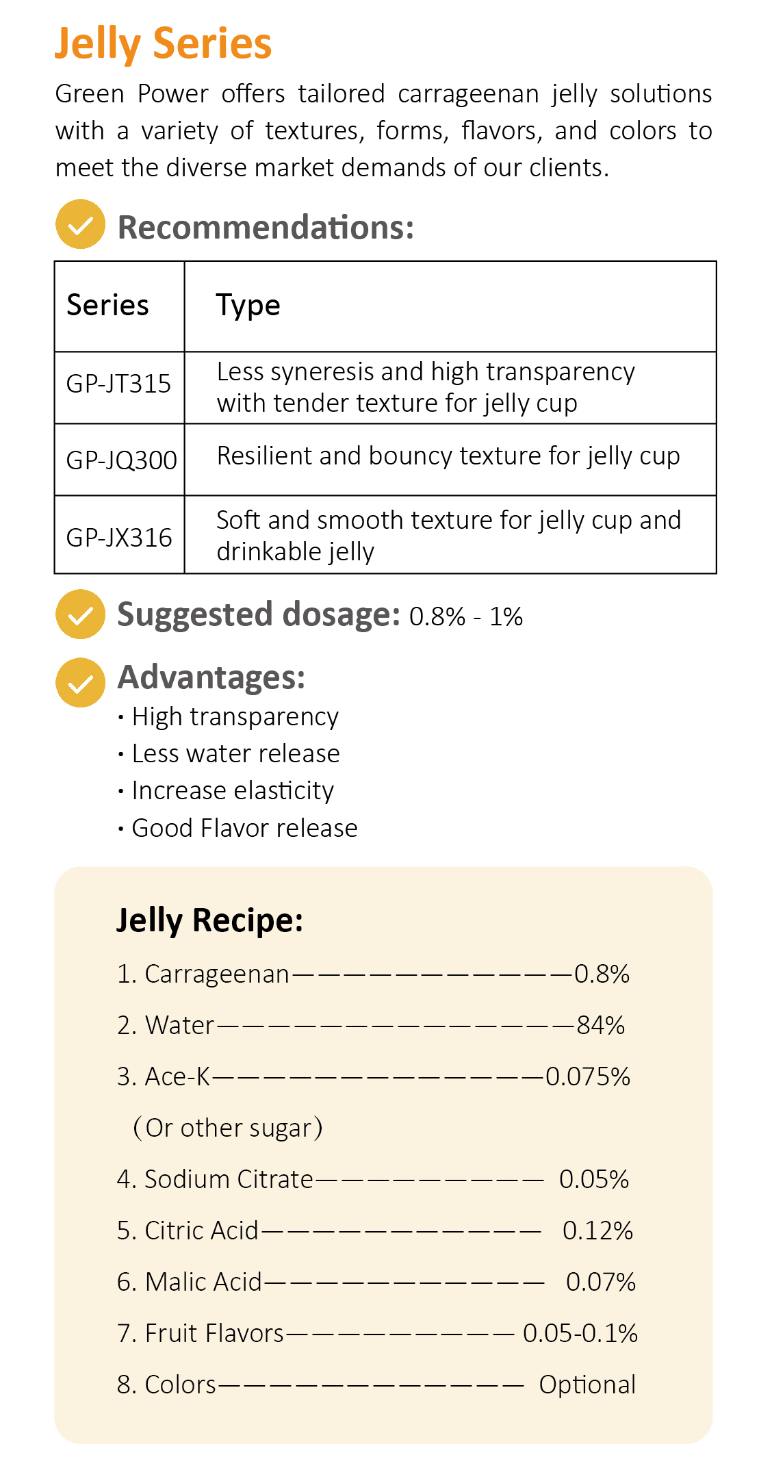The Versatile Role of Carrageenan in Jelly Applications
In the world of food production, the choice of gelling agents can significantly influence the texture, stability, and overall quality of products like jelly. Among the various options available—agar, gelatin, and pectin—carrageenan stands out for its unique advantages. This soft article explores the different applications and types of carrageenan in jelly, highlighting its superiority over traditional gelling agents.
Understanding Gelling Agents
Agar: While agar is a popular choice, it often fails to provide the desired elasticity and can be more expensive. The rigidity of agar can result in a jelly that lacks the desired mouthfeel, which may not meet consumer expectations.
Gelatin: Gelatin-based jellies present challenges due to their low coagulation and melting points. This necessitates low-temperature storage, complicating logistics and limiting shelf life. Additionally, gelatin's animal origin may not be suitable for all consumers, particularly those seeking plant-based options.
Pectin: Although pectin is a natural gelling agent, its use often requires the addition of highly soluble sugars and precise pH adjustments to achieve the right gel structure. This complexity can add time and cost to production processes.
The Advantages of Carrageenan
Carrageenan emerges as an exceptional alternative, offering several key benefits:
Elasticity and Texture: Carrageenan provides a smooth and elastic texture, enhancing the overall mouthfeel of jelly products. This property is essential for creating jellies that are not only visually appealing but also enjoyable to eat.
Plant-Based: Perfect for vegans and vegetarians, carrageenan is derived from red seaweed, making it a great choice for all dietary preferences.
Versatility: Carrageenan can be tailored to different applications, such as instant jelly powders and fruit-in-jelly products. Its ability to form stable gels allows for diverse flavor and ingredient combinations, from classic fruit flavors to innovative recipes incorporating other ingredients.
Stability at Varying Temperatures: Unlike gelatin, carrageenan maintains its gel structure at higher temperatures, reducing the need for refrigeration during storage and distribution. This feature simplifies logistics and expands the potential market for jelly products.
Compatibility with Other Ingredients: Carrageenan works harmoniously with other gelling agents, such as konjac gum, allowing for customized formulations that can enhance gel strength and stability even further.
Carrageenan in Action
In various applications, carrageenan showcases its versatility:
Instant Jelly Powder: Carrageenan is a crucial ingredient in instant jelly powders, allowing consumers to prepare delicious jelly quickly and easily. Its gelling properties ensure that the final product has the right consistency and flavor profile.
Fruit-in-Jelly Products: The use of carrageenan in fruit-in-jelly applications ensures that the fruit pieces remain suspended within the jelly, providing a visually appealing and texturally satisfying product.
Classic Jellies: For traditional jelly formulations, carrageenan delivers a familiar texture that consumers expect, all while simplifying the production process and reducing costs associated with other gelling agents.
How to Make Delicious Jelly with Carrageenan
Step-by-Step Instructions
Prepare Your Ingredients: Measure out the carrageenan and liquid. If using fruit juice, choose 100% juice for the best flavor.
Mix Carrageenan and Liquid: In a saucepan, combine the carrageenan with your chosen liquid. Stir well to avoid clumps.
Heat the Mixture: Bring the mixture to a gentle boil over medium heat, stirring continuously. This activates the gelling properties of carrageenan.
Sweeten to Taste: Once the mixture is boiling, add your sweetener and any additional flavorings. Stir until fully dissolved.
Cool and Set: Remove the saucepan from heat and allow the mixture to cool slightly. Pour it into molds or a serving dish. Let it sit at room temperature for about 15-30 minutes, then transfer it to the refrigerator to set fully (usually 1-2 hours).
Enjoy Your Jelly: Once set, carefully unmold or serve directly from the dish. Your homemade jelly is now ready to be enjoyed!
Carrageenan not only enhances the flavor and texture of your jelly but also allows for creative experimentation with various juices and additions. With a little time and creativity, you can enjoy delicious, homemade jelly that suits your taste preferences and dietary needs. Embrace the joy of making jelly with carrageenan and delight in this refreshing treat!



